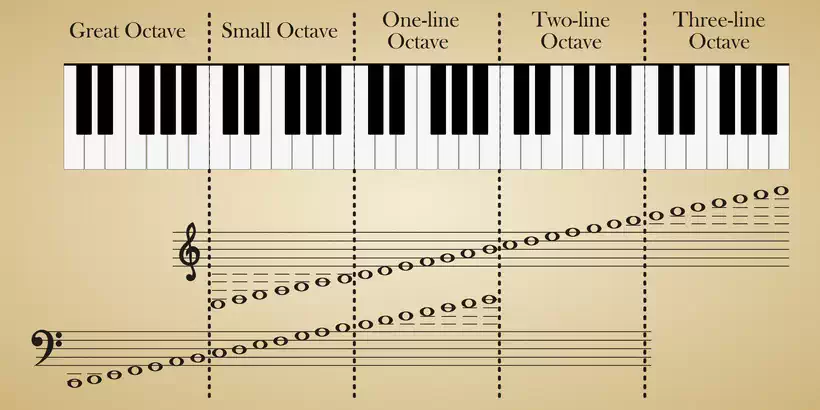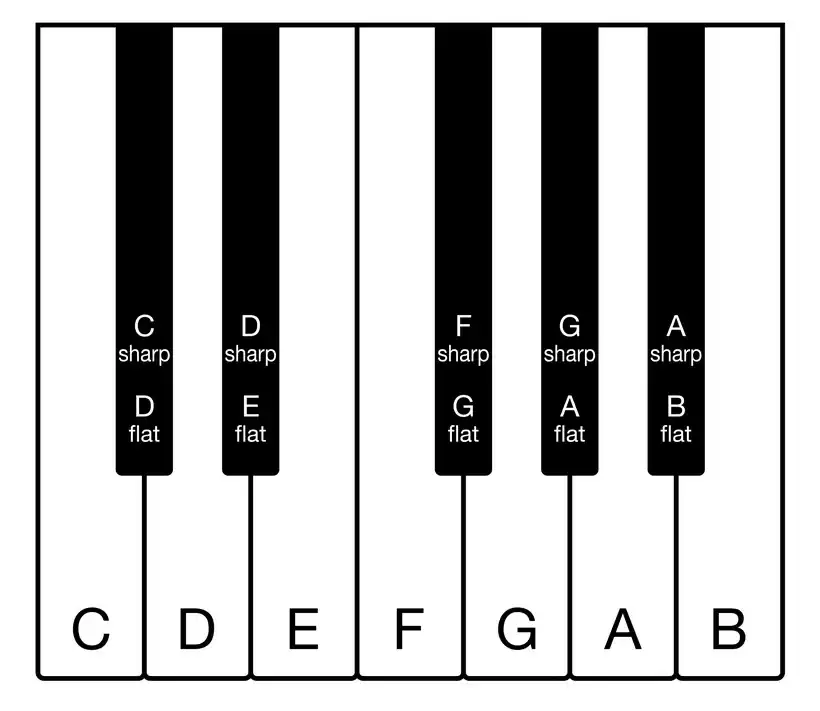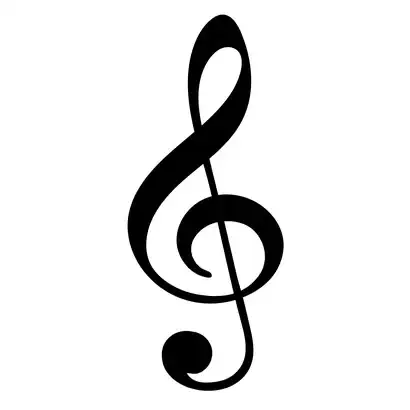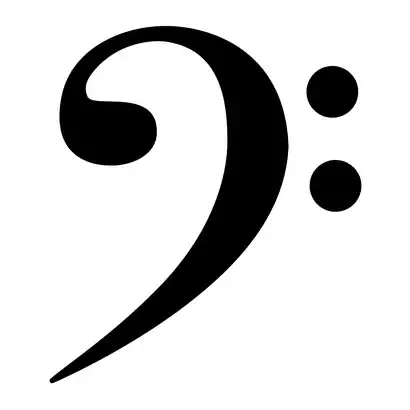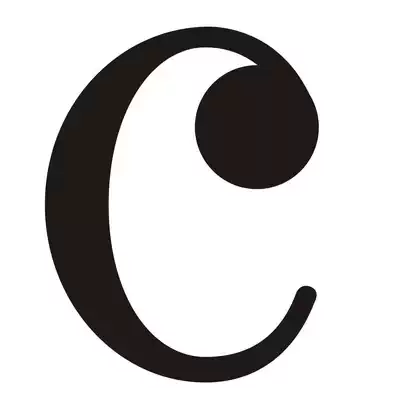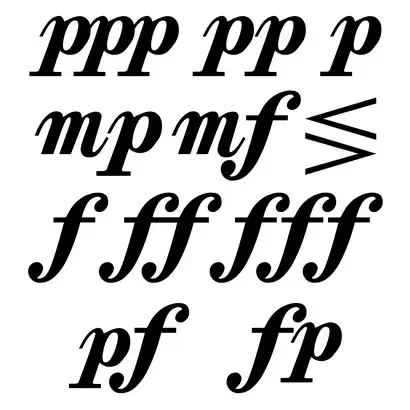Learning to play the piano is an exciting journey, but reading sheet music poses a serious challenge to most students. After all, if you’re looking at written music and can’t name one note, it’s easy to become discouraged. But with some focus and determination, it’s entirely possible to learn to read sheet music fairly quickly. If you’re looking to learn piano notes and how to read them, this article is a great place to start.
Learning Notes on Piano: a Primer
To really learn the notes on the piano, you need to understand the names of the notes on the keyboard as well as how to recognize them on sheet music. And to understand these things, you first need to know a bit about the musical alphabet.
1. Introducing The Musical Alphabet
Before we start looking at the piano keyboard, it’s important to have a general sense of the musical alphabet or the names of all the notes used in Western music.
The natural notes (notes excluding sharps and flats) of the musical alphabet are A B C D E F G. After G, the alphabet simply starts over at A — there’s no H! Here’s the musical alphabet complete with sharps:
A A# B C C# D D# E F F# G G#
The above musical alphabet contains all the note names. The distance between each note listed is called a half step — this is a term you may hear if you decide to study more music theory. If you move two half steps, that’s a whole step.
You probably noticed that some notes do not have a sharp between them. On the keyboard, these notes are two adjacent white keys with no black key between them.
Before we continue, it’s important to understand that sharp notes are the same as the flat version of the next note. So for example, A sharp (A#) is the same as B flat (Bb). Here’s a quick list of equivalent notes:
- A# = Bb
- C# = Db
- D# = Eb
- F# = Gb
- G# = Ab
If you want to learn more, check out this helpful video for a quick intro to the musical alphabet!
2. Notes On The Piano Keyboard: White Keys
Most of the white keys on the piano keyboard are natural notes or those with no sharps or flats. The first note most music students learn is middle C. To find it on your keyboard or piano, look at the middle of the keyboard. You should see two white keys next to one another. Middle C is the one to the right. It’s also illustrated in the picture below.
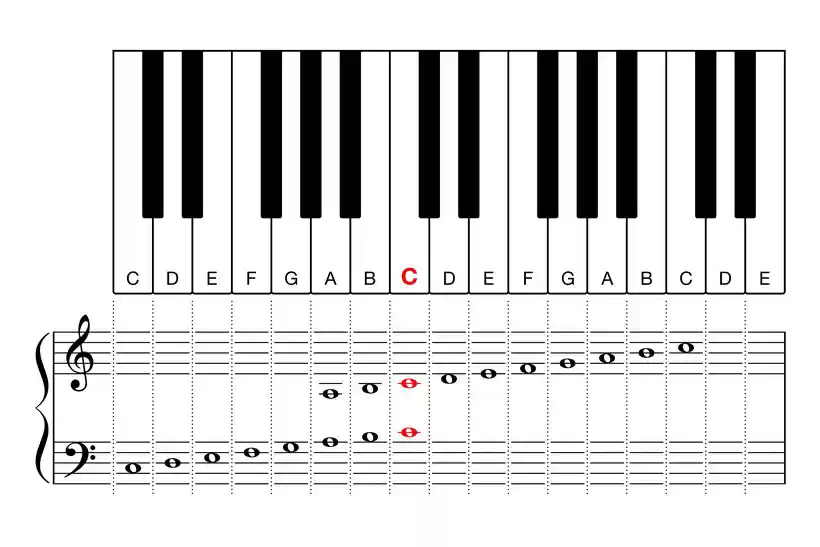
If you continue hitting white keys to the left or right of middle C, you will eventually hit C again, but at a lower or higher pitch. That’s because, in music, the alphabet repeats itself. And since the distance between middle C and the next higher or lower C is eight notes, each iteration of the musical alphabet is an octave. Octaves are a lot easier to visualize on the piano, as they are just groups of eight white keys:
Each octave contains eight whole steps and 12 half steps. On the piano, a half step just means moving to the next key. Sometimes that next key will be a black key *like when you move from A to A sharp). But sometimes it will be another white key (like when you move from B to C).
3. Notes On The Piano Keyboard: Black Keys
The black piano keys are known as “accidentals.” In terms of the musical alphabet, black keys will appear anywhere there is a sharp between two natural notes.
As we mentioned above, any sharp note in music also has a corresponding flat note. Though their names are different, these notes sound the same. The above picture shows you the sharp and flat names for each black key in an octave.
When you think about learning all the notes on the piano, it can feel overwhelming. Just remember that the piano is made up of a series of octaves — once you cycle through all the notes in the musical alphabet, that cycle just repeats itself again.
4. Introducing Piano Sheet Music
Some players new to piano avoid reading piano sheet music. But if you want to go far as a piano player, taking the time to read music is essential. While guitar players often use tablature, a simplified musical notation, there’s no similar notation for pianists. Chances are good that if you want to learn to play a new piece of music, you’ll need to be able to read sheet music.
If you’re just learning to read sheet music, you’ve probably noticed two lines of music. Each is called a staff. The line of music at the top is headed by a treble clef (Image Left). And the line beneath is headed by a bass clef symbol. (Image Right)
As you can tell by the names, notes under the treble clef are higher in pitch and usually played with the right hand. Notes under the bass clef are lower in pitch and are usually played with your left hand. The two staves help you play with your right hand and your left hand at the same time.
Playing two notes at once may sound like a challenge, especially if you’re just learning to read music. But don’t worry — most beginners start playing one staff at a time. When the treble and bass staffs are combined, they form what is called a “grand staff.”
Before we continue, it’s important to know that piano players use an easy numbering system for fingers. As you’re learning to read sheet music, some pieces will use these finger numbers to help you learn how to play a piece. Here are the finger numbers (they are the same for each hand):
- Thumb: 1
- Index finger: 2
- Middle finger: 3
- Ring finger: 4
- Pinky finger: 5
5. Piano Notes On The Treble Clef Stave
Now you have a sense of all the notes on the piano keyboard. But how are they written on sheet music? Note names are different on the treble clef and the bass clef, so really understanding how to read sheet music for piano can take some time. Let’s start with the notes on the treble clef.
As you learn to read notes on the treble clef, there are a couple of mnemonic devices that may help you. The notes on the five lines of the staff from bottom to top are E G B D F. You can remember this as “every good boy deserves fudge.” (Some music teachers use “every good boy does fine” as an alternative to “every good boy deserves fudge.”)
For the note names in spaces between bar lines, you get F A C E from bottom to top. This is fairly easy to remember as “FACE.”
The picture below shows you what the C major scale looks like on both sheet music and on the keyboard. It’s a good introduction to what notes look like on the keyboard vs. on sheet music:
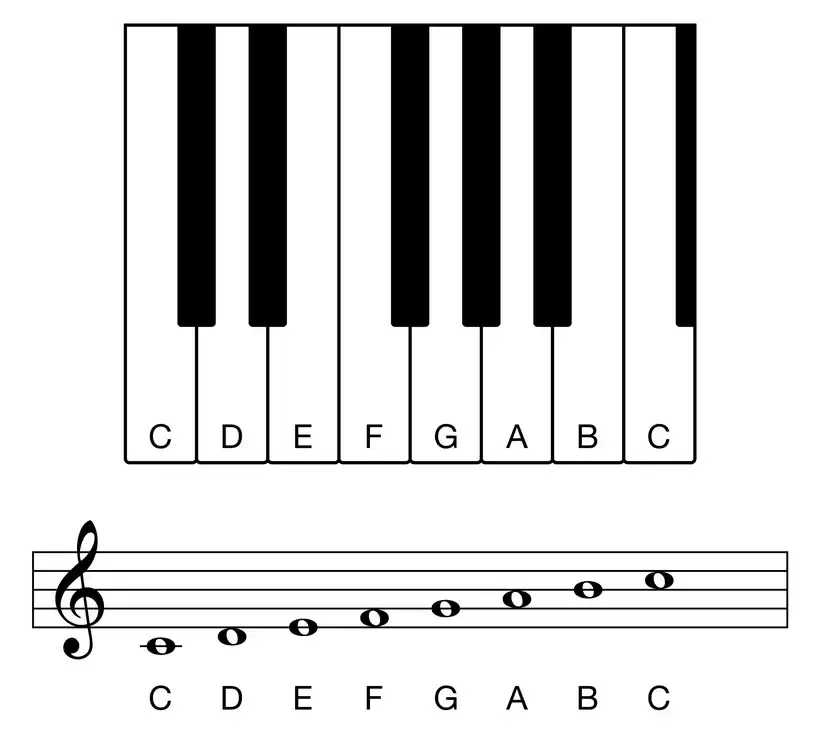
If you print out some blank staff paper (often found as a free download on many different websites), you may find it helpful to label the notes in pencil. Just writing the note names can help you remember them. And once you’ve labeled the note locations, you can keep them as a handy reference as you learn to play from sheet music.
6. Piano Notes On The Bass Clef Stave
You already know that the low notes appear on the bass clef stave or the line of music under the treble stave. It’s easy to assume that the note names on this stave are just like those on the treble stave.
From bottom to top, the notes on the lines of the staff are G B D F A. Though it’s a little similar to the treble clef mnemonic, you can remember this one as “Good Boys Deserve Fudge Always.”
In the spaces between lines, from bottom to top, the notes are A C E G. You can remember this one as “All Cows Eat Grass.” (The note immediately above the A-line of the staff itself is B, so it can be helpful to add a B after “All Cows Eat Grass.”).
If you have trouble remembering which note goes where on the staff, it can be helpful to know that the two dots on the bass clef are on either side of the line for F.
The image below illustrates the note names on both the bass clef and the treble clef. As you can see, the two share one note in common: middle C.
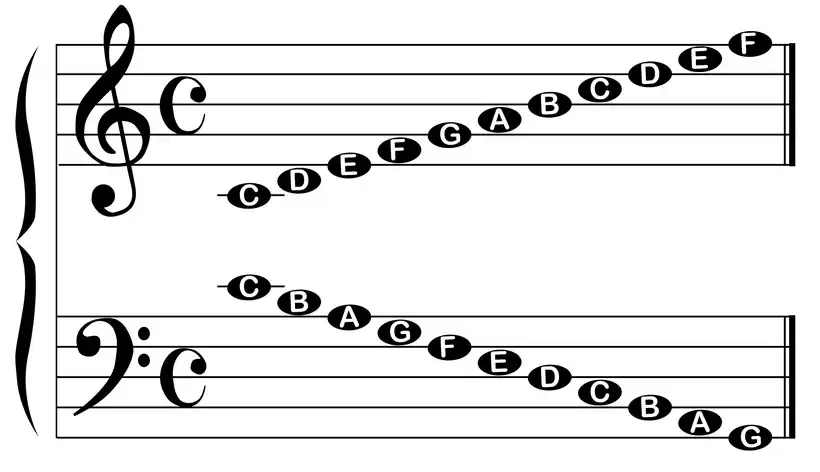
You found middle C earlier and saw that it essentially divides the piano in two. Music on the bass clef is almost always played to the left of middle C, while the music on the treble clef is to the right.
7. Whole Notes, Half Notes, And More
In order to be able to read piano music, you don’t just need to know the note names. You’ll also need to learn about whole notes, half notes, etc., and how many beats each one lasts. Here’s a breakdown of the note values you need to learn:
- Whole notes – Whole notes last four beats.
- Half notes – Half notes last two beats, or half of a whole note.
- Quarter notes – These are what most people picture when they imagine music notes. Each quarter note is one beat or a quarter of a whole note.
- Eighth notes – Eighth notes last half a beat. They are fairly easily recognizable thanks to their “flags.”
- Sixteenth notes – Sixteenth notes are a quarter of a beat.
- Thirty-second notes and sixty-fourth notes – These generally only appear in more advanced pieces of music.
This helpful image shows you what each note type looks like and breaks down the relationship between them:
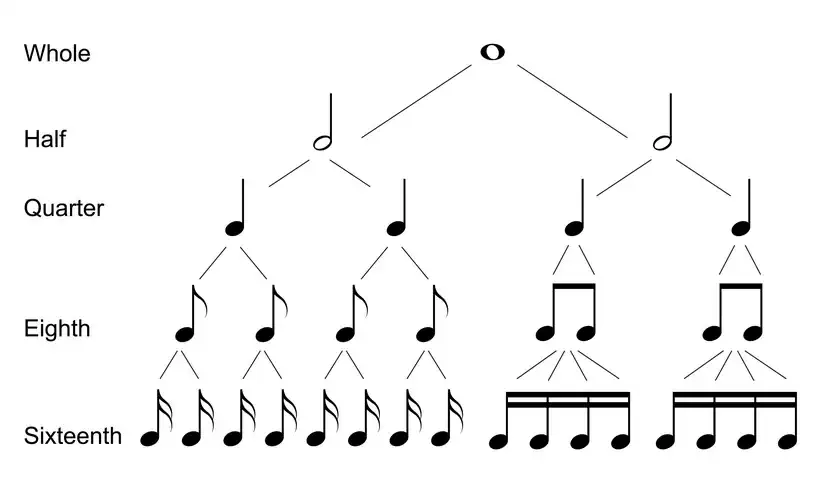
You may sometimes see a note with a dot next to it. The dot adds half of the note’s value. Say you see a dotted half note. The value of a half note is two beats. So you add one beat (half of two). So the dotted half note should last three beats.
8. Learning About Rests
Now you have some understanding of different music notes and what they mean. But as you begin reading music, you’ll soon see that you need to know how long to pause before playing the next note. That’s what rests tell you.
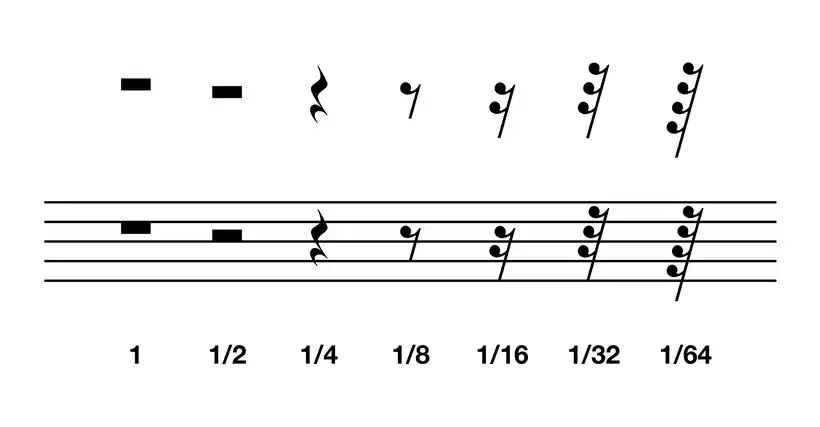
Each note value we mentioned earlier has a corresponding rest value:
- Whole rest – Pause for four beats.
- Half rest – Pause for two beats.
- Quarter rest – Pause for one beat.
- Eighth rest – Pause for half of a beat.
- Sixteenth rest – Pause for a quarter of a beat.
The above illustration shows you rest types and what they look like. Please note that while it includes thirty-second and sixty-fourth rests, these are not commonly used.
9. What’s A Time Signature?
Reading piano notes is one thing, but you need a time signature to tell you how beats are grouped. You probably can already see that sheet music is divided into measures using vertical lines.
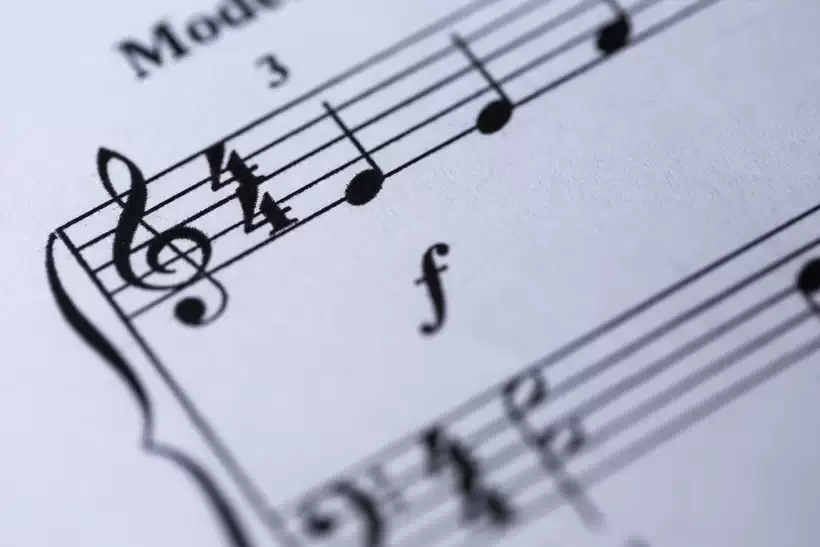
Time signatures are written with two numbers, one over the other. The upper number will tell you how many beats are in a measure. The lower number will tell you what counts as a beat. So for example, if your time signature is 3/4, the 3 tells you there are three beats per measure. The 4 tells you that a quarter note is one beat.
You may sometimes see a symbol that looks like image on below left. This indicates “common time,” or a 4/4 time signature. That just means that there are four beats per measure and that a quarter note counts as a beat.
10. The Importance Of Dynamic Marks
Reading music for the piano often requires you to go beyond the basics. When composers create a piece, they often want to include some direction on how to play certain notes. If you’re very new to piano, you may not see a whole lot of dynamic marks. (Image Above Right). But just in case, here are some common ones:
- piano (p) — play softly
- forte (f) — play loudly
- pianissimo (pp) — play very softly
- fortissimo (ff) — play very loudly
- crescendo (cresc.) — play gradually louder
- decrescendo (decres.) — play gradually softer
11. Going Forward
Learning to read sheet music for piano might seem overwhelming. But if you want to eventually be able to sight-read music or start playing with other instruments, being able to read music is an important start. Learning new songs gets a lot easier, too.
Eventually, your ability to read notes will seem to come from muscle memory. But as you learn, be sure to be patient with yourself. Some players find that placing stickers on the keys with the names of the notes works well, while others may want to hang a chart or poster with the note names. For some tips on learning and remembering notes on the piano, check out this video.
Regardless of your preferred method of memorizing the note names, one of the best ways to really become competent at reading sheet music is just to practice. As you’re learning, many courses or instructional books will include simple practice exercises that include a few notes at a time. These exercises can be helpful, as can finding easy sheet music online.
However, if you find sheet music to practice with, always make sure you listen to the piece you’re playing. That will help you double-check your playing for timing and accuracy.
Want Some More Guidance?
Learning music is certainly rewarding. And while teaching yourself piano is possible, having guidance from a qualified instructor can make the difference between hitting a plateau and continuing to improve. You don’t need to seek out in-person piano lessons, either: there’s a wealth of online courses out there that can help you learn to play piano in any genre you wish.
Final Thoughts
Lots of people enjoy the sound of piano music, and now you’re well on your way to being able to play it! Learning piano notes on both sheet music and on the piano itself is a major accomplishment. What do you think? Do you have any helpful tips we left out? Let us know in the comments, and don’t forget to like and share if you found it useful!

